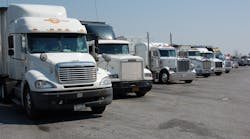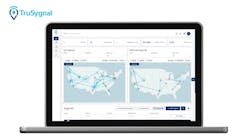A new study completed by two researchers at North Carolina State University and partly supported by a grant from the National Science Foundation finds that trucks built since 2007 have substantially lower emission rates than trucks built earlier. Furthermore, trucks equipped with technologies designed to comply with 2010 Environmental Protection Agency emission requirements are delivering “significant reductions” in particulate matter (PM) and oxides of nitrogen emissions (NOx).
Lead author for the study, Ph.D. student Gurdas Sandhu, and co-author Dr. Chris Frey, professor of civil, construction and environmental engineering at the university, used a portable emissions measurement system to sample exhaust from five diesel trucks while the trucks were in use on roads and highways. The paper documenting their work, “Real-World Measurement and Evaluation of Heavy Duty Truck Duty Cycles, Fuels, and Emission Control Technologies,” is soon to be published in Transportation Research Record, the journal of the Transportation Research Board (TRB).
The report concludes that: “…. successively more stringent emissions standards are efficacious in reducing real-world emissions under actual driving conditions. Although the vehicle sample sizes here are too small to support conclusions regarding trends in fleet average emission rates by model year, they are consistent with a hypothesis that in-use emissions are substantially lower for 2010 model year trucks than any prior model year, and that trucks manufactured since 2007 have substantially lower emission rates than those from prior model years.”
Specifically, the 2010 truck had NOx emissions approximately 99% lower than that of the 1999 model year truck, according to the study. The PM emission rates of the 2007 to 2010 trucks were also “substantially lower” than those of the 1999 and 2005 trucks. The only exception to the steady reduction in emissions was that the 2005 model year truck “appeared to have higher PM emission rates than the 1999 truck.”
“These requirements for new emission control technologies have increased costs for truck owners and operators, and we wanted to know whether there was any real benefit,” Frey said. “We found that there is a huge reduction in both PM and NOx emissions.”
All of the test vehicles were owned and operated by the North Carolina Department of Transportation (NCDOT) for the purpose of delivering highway maintenance supplies to field sites at various locations in the state. Each pulled a 48-foot trailer on regular routes during the measurements.
Four of the test trucks were International models equipped with ISM or ISX engines from Cummins, including one model year 1999 (the baseline truck), a model year 2005 making use of exhaust gas recirculation (EGR) only, and 2007and 2009 vehicles both utilizing EGR plus diesel oxidation catalysts (DOC) and particulate filters (PF). The fifth truck was a 2010 model year Mack CHU613, which utilized all of the above mentioned emission reduction technologies plus selective catalytic reduction (SCR).
Would the researchers like to have gone even further with this study? “Of course,” noted Frey. “It is always good to get more data, but that is always the case with research,” he told Fleet Owner. “For instance, it would have been useful to get more information on the concentrations of emissions upstream of the SCR treatment. That would have let us see how the SCR is really performing minute-by-minute.”
According to Frey, his group within the university has been involved in this sort of real-world vehicle use research for about 12 years. “This kind of vehicle research is a specialty of my group,” he said. “We’ve been doing this type of duty-cycle analysis of emissions for some time [including studying the real-world performance of hybrids, biofuel-, diesel- and gasoline-powered vehicles]. Essentially, we can measure emissions from anything with a tailpipe and analyze them in a variety of ways, such as the exhaust flow rate, grams of emissions per task, grams of emissions per linear mile, etc.
“Our focus is always emissions as they tie back to energy use or specific activities,” he added. “The goal is to help find ways to reduce emissions as a by-product [of vehicles doing work].”
Frey also had high praise for the trucking industry and what it has achieved in the way of emissions reduction. “Trucking has really done an admirable job,” he said.
Other vehicle emissions research projects on Frey’s schedule for the near future include a look at how emissions from refuse trucks vary based upon the configuration of the vehicle—side loaders versus rear loaders, etc. and a study to measure how the use of traffic roundabouts instead of the more traditional signal-controlled intersections impact vehicle emissions.



